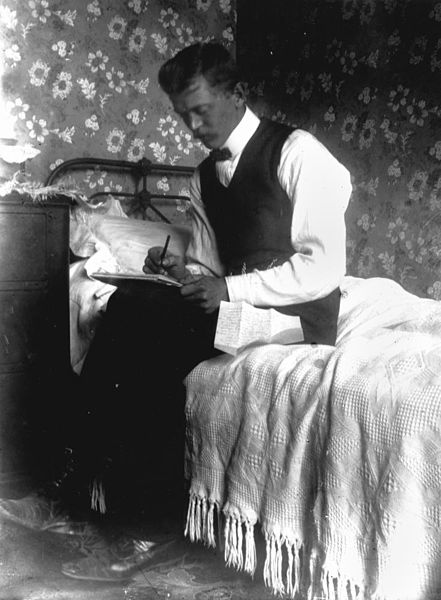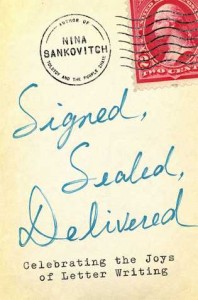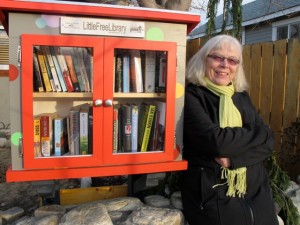
Source: Wikimedia Commons: Portrait of a man writing letter 1900-1910 ( John Oxley Library, State Library of Queensland).
by Allison Howard
There is something enticing and irresistibly voyeuristic about reading the personal letters of others. They offer a rare peep into the window of the writer’s private life. In Signed, Sealed, Delivered (2014, Simon & Schuster), Nina Sankovitch opens that window a little wider for us. Her discovery of a trunk of early twentieth-century letters transports her vicariously into the letter writer’s world, and because of her passion, research, and attention to detail, we too are transported.
 Sankovitch’s first book, Tolstoy and the Purple Chair, introduced us to her remarkable observational skills as she documented the books she read for an entire year following the death of her cherished sister. With warmth, intelligence and wit, she took us on her therapeutic journey. In Signed, Sealed, Delivered, the author invites us to accompany her on a different sort of journey, one that is at once an historical study, a curative lesson, and an inspirational excursion into the rich world of letters.
Sankovitch’s first book, Tolstoy and the Purple Chair, introduced us to her remarkable observational skills as she documented the books she read for an entire year following the death of her cherished sister. With warmth, intelligence and wit, she took us on her therapeutic journey. In Signed, Sealed, Delivered, the author invites us to accompany her on a different sort of journey, one that is at once an historical study, a curative lesson, and an inspirational excursion into the rich world of letters.
The trunk she found, in a decrepit shed in the backyard of an old row house in New York City she and her husband had recently purchased, contained correspondence written by one James Seligman to his mother, Addie. The young man had left home to attend Princeton University, and through his youthful eyes we see the world opening with opportunity.
A good-natured young man with a sense of humour, James loved being away at Princeton and wrote enthusiastically of living arrangements, his classes, the meals, the fun to be had (clearly a priority), and, like all college students, his continuous need for money. On that subject he writes: “I cashed your first check, and found very little trouble in cashing it. In fact, if you have more checks you need cashed, kindly forward same and I will oblige.” James also travelled during college breaks and wrote witty, descriptive letters about his experiences and the well-heeled people he met and with whom he socialized.
We can only guess at his mother’s replies, as none of her letters survive, but in clear reference to her inquiries about his health and well-being, he writes: “My diet consists principally of food. My health is fine.”
The author talks about having “fallen in love” with James Seligman through his touching letters to his mother — and in her heart he has become and stayed a friend. She speculates that Addie Seligman kept the letters in the hope that a future reader would know and love her son as she did, and by so doing “allow him to live a little longer.” This thought causes Sankovitch to ache, in these days of truncated texts and tweets, for the same kind of written record from her own son, whom she encourages with gentle reminders and a gift of ivory note cards.
Also explored in these pages is the correspondence of famous letter-writers including Georgia O’Keeffe, Gertrude Stein, and Emily Dickinson, as well as lesser-known ones, like the mother who penned a sad and desperate note and pinned it to her three-week-old infant, left at a Foundling Hospital in New York in 1875. Writes the mother: “Alone and deserted, I need to put my little one with you for a time … I trust you will be kind….” Sankovitch’s letter-writers range from long-departed politicians to writers and artists to fictional television characters. And she doesn’t flinch from honest revelations about her own life as she shares variously magical, mundane, and painful letters from her family — including her faithful letter-writing mother — and friends.
As this book aptly shows, letters have long served many purposes aside from purely informing the reader of news and events. They have explained the horrors of war, kept the flame of love alive, reunited old lovers, been confessional tomes, and taught us lessons. In both real and fictional life, they have served to bridge time and place — as Sankovitch has done in this “celebration.”
For those who desire to understand history through personal correspondence, as I do, this book will be a delight. The only frustration is that Signed, Sealed, Delivered will leave you wanting to know more — but then, that is the nature of letters: they are always just a peek and never a full view.
♦ ♦ ♦

Allison Howard, beside her Little Free Library. For more about this initiative, see http://littlefreelibrary.org
ALLISON HOWARD is a former social worker living in Penticton, British Columbia. Besides enjoying the many outdoor activities that the beautiful Okanagan Valley provides, Allison is an avid photographer who shows her work at galleries and other venues. She is also co-editor of A Memoir of Friendship: Letters Between Carol Shields and Blanche Howard and has published personal essays in Canadian Woman Studies and elsewhere. Allison sees a link between the creative worlds of writing and photography, and the simplicity and charm of life in British Columbia’s southern interior encourages these twin passions. Visit Allison Howard Photography.
Also read Allison’s guest post “Vanishing Letters of War: What We Stand to Lose”